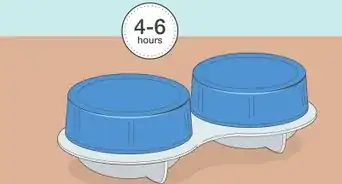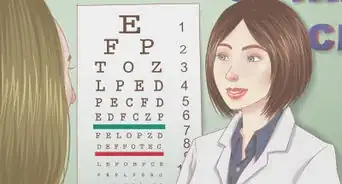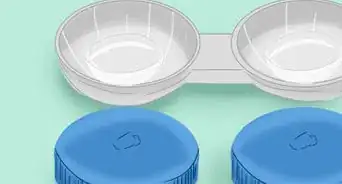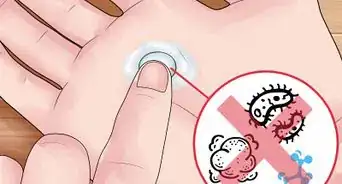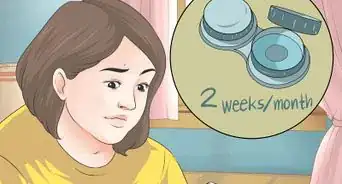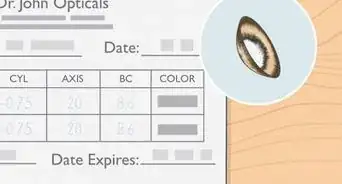This article was co-authored by David Felsted, DO. Dr. David Felsted is a Comprehensive Ophthalmologist based in Flagstaff, Arizona. He specializes in cataract and refractive surgery, micro-invasive glaucoma surgery, ophthalmic lasers, dry eye disease, diabetic retinopathy, and ocular trauma. Dr. Felsted holds a BS in Accounting from Brigham Young University and a Doctor of Osteopathic Medicine from Midwestern University. He completed his Ophthalmic residency at The Medical College of Georgia.
There are 7 references cited in this article, which can be found at the bottom of the page.
wikiHow marks an article as reader-approved once it receives enough positive feedback. In this case, several readers have written to tell us that this article was helpful to them, earning it our reader-approved status.
This article has been viewed 257,723 times.
Colored contact lenses are decorative accessories worn on the cornea of the eye. Prescriptive contact lenses are medical devices, correcting your vision. Non-prescriptive contact lenses are purely for decoration. For best results, choose colored contacts that enhance your appearance.
Steps
Choosing the Right Pair of Contacts
-
1Learn more about colored contacts. Decorative colored contacts cover your iris in a new color. This can closely match your natural color to enhance it, or it can be dramatically different. Colored contacts will never look exactly the same on any two people.[1]
- Opaque lenses are meant to entirely cover your natural eye color. If you have dark eyes, you might need to get opaque lenses in order to alter your eye's natural color.
- Color-enhancement lenses are intended to shade your existing eye color. If you have light colored eyes, these lenses can brighten your natural shade or change it altogether. They may not have any effect on dark eyes, however.
- Equinox lenses are lenses that have a dark ring around the iris. It's both a subtle and a dramatic effect, particularly in light eyes. It's subtle because it's not immediately recognizable what is different about the person, but it's definitely noticeable. These are sometimes called "circle lenses".
- Custom-tinted or sports tinted lenses are increasingly popular choices. These are both cosmetic and practical, as the choice of color may enhance sports ability. Colored contacts can reduce glare, enhance contrast sensitivity and heighten depth perception. For example, a tennis player may wear green contacts in order to see the tennis ball more clearly.[2]
-
2Determine your skin color. Dark skin color can be seen in terms of "warm" or "cool". Cool means your skin has pink, red, or bluish undertones. Warm skin has undertones of yellow or peach. Some people have neutral skin, which is a mixture of the warm and cool.[3]
- Is your skin tone more olive in complexion? If so, you have a warm skin tone. Do you look best in bright white, black, or silver tones? You might have a cool skin tone. You'll likely look best in brown, amber or green contacts.
- If you have lighter skin, the best way to determine whether your skin has warm or cool tones is by looking at your veins. If your veins appear blue, you likely have cool tones. If your veins appear greenish, you likely have warm skin tones.
Advertisement -
3Consider your natural eye color. Most dark-skinned girls have dark eyes, but not all. If you have light eyes, a subtle colored contact lens might be green or blue. If you have dark eyes, you might choose opaque colored contact lenses.
- Hazel or honey-brown lenses will be more natural on a dark eye. Bright colors, like blue, purple, or green, will make you more noticeable.
- You can also choose to enhance the natural color of your eyes using colored contact lenses.
-
4Consider your hair color. After your skin, your hair will probably be the first thing that someone sees near your eyes. If your hair is dark, consider dark lenses, or dark colors like violet or dark blue.[4]
- If you have a dramatic hair color, like platinum-blonde, or a combination of colors, you might want to choose a dramatic eye color as well. Consider opaque contacts in shades of emerald green or ice blue.
- If you don't dye your hair, dramatic contacts may look even more dramatic. Try on different colors before making a final decision.
-
5Think about the desired effect you want from your contacts. Do you want to make a dramatic statement with your colored contact lenses? Or would you rather enhance your natural appearance? Using colored contacts can result in either effect.
- Bright colored contact lenses on naturally dark eyes will definitely make your eyes noticeable.
- You might decide to purchase multiple contacts in order to try different effects for different occasions. For example, maybe you want to purchase one set of contacts for work, and another for night life.
-
6Check out how your eyes look in different lighting. Wear your contacts in low lighting, and see how the effect of your colored contacts changes. The effect will be different in bright lighting. Move to different areas, carrying a hand-held mirror if you need to, to see how your new contacts will look in different lights.[5]
- Consider where you're most likely to wear your new colored contacts. Are you planning to wear them out clubbing? Or are they for daily wear?
- If you've narrowed your choices down to 2 different colors, try wearing a different color in each eye as you move between different lighting. This might make your choice easier.
- Remember, you can always purchase more than 1 set of colored lenses for different purposes.
-
7Talk to an eye doctor. Remember that contact lenses, even decorative ones, are medical devices. Even if your contacts don't require a prescription to help correct your vision, they should be fitted to your eye. Anyone selling contact lenses must verify your prescription by calling your doctor.[6]
- Poorly fitted or cheaply made lenses are more likely to result in eye injury or infection.
- Avoid ordering contacts over the internet, from a costume shop, flea market, or street vendor.
Caring for Your Contact Lenses
-
1Learn more about different types of contacts. Whether your contact lenses are prescribed to correct your vision, or whether they're decorative, your contacts will be one of many kinds. Most contacts are soft contacts, which means that they are flexible. Soft lenses allow oxygen to pass through to the cornea. Soft contacts are disposable, and can be worn for one day (daily disposable), 2 weeks, or 4 weeks. Lenses can also be hard, which means they are rigid and breakable. These contacts are also known as RPGs or "rigid gas permeable." [7]
- Contacts can also be bifocal.
- Even though contacts can be worn for many days, it's best to remove them each night as you sleep.
- RPGs may be the best choice of contact lenses for someone with allergies.
- Even though RPGs once had a reputation for "popping out" of the eye, newer models have greatly improved the comfort level and sustainability.
- Soft lenses have a greater chance of sliding up underneath the eyelid, or getting folded while still in the eye.
-
2Wear contacts as directed. People who wear contact lenses have an increased risk of infection to the cornea. Wearing contacts in a way other than prescribed - e.g. wearing daily contacts for a week, or wearing them overnight - may result in temporary, or even long-term damage to the cornea.[8]
- Soft, extended-wear contacts have the highest risk of developing protein build-up on the lens. This may result in lens-related allergies.
- Infections often result from poor lens cleaning as well as misuse.
-
3Learn more about risk factors associated with wearing contacts. Even though contacts are popular and easy to wear, there are still some hazards associated with wearing contact lenses. Eye infections, scratching the cornea, and allergic reactions as demonstrated by itchy, red, watery eyes are among the most common results from wearing contacts, even if you follow all the guidelines.[9]
- If you choose to wear contacts, you need to also be able to commit to taking care of the contact lenses as well as your own eyes.
- If you're wearing contacts as a decorative accessory, make sure your lenses are FDA-approved.
- Anyone selling contact lenses is required to get a prescription from your doctor - even if you don't require prescriptive lenses! The reason for this is that contact lenses must be fit to your eye, and contacts that don't fit properly could result in damaging your eye or even causing blindness.[10]
-
4Check your medical history. If you're someone who frequently gets eye infections, has chronically dry eyes, or serious allergies, you may not benefit from wearing contact lenses. If you work in an area with a lot of particle matter in the air, you might also want to avoid contacts.[11]
- If you're the kind of person who has a hard time doing the daily washing and caring for contacts that they require, you might want to avoid wearing contacts.
- Wearing contact lenses means that you'll have to take them out in the evening. If you have a schedule where your evenings are greatly varied, you might want to stick to glasses. If you're planning to just wear decorative colored lenses, make sure you bring a case to store them in when your eyes are tired and you need to remove your lenses.
-
5Keep your contacts clean. Always wash your hands well with soap and water before touching your contact lenses. It's recommended that you clean your contact lens case every day, and change your case at least once every 3 months.[12]
- Never share your colored contact lenses with someone else.
- Homemade contact lens cleaning solutions have been linked to serious eye infections. Always purchase FDA-approved saline and cleaning solution.
- Contact lens cases are designed to be disposable. Anytime you get a new bottle of solution, you should throw away the old case and get a new one. Most bottles of solution now come with a case.
-
6Notice changes in your eyes. Take out your contact lenses and call your doctor if you start to notice signs of eye discomfort or distress. If your eyes start to hurt, itch, or become red and watery, you may have an eye infection or injury. If your eyes may become overly sensitive to light, or you have blurry vision, call your doctor.
- Your eye may feel scratchy, as if there's something stuck in it. This can be an indication of a scratch on your cornea.
- Always start by taking your contact out when you notice these signs.
Warnings
- Don't buy contacts over the internet. It's important that they be FDA-approved and fitted to your eye.⧼thumbs_response⧽
- Never clean your contact by putting it in your mouth, then in your eye.⧼thumbs_response⧽
- Never store your contacts in anything other than a contacts case with contact solution.⧼thumbs_response⧽
- Please remember that all contact lenses come with risks, including scratching the cornea, allergic reaction, even blindness.[13]⧼thumbs_response⧽
References
- ↑ http://www.healthguidance.org/entry/3102/1/How-Do-Colored-Contact-Lenses-Work.html
- ↑ https://www.allaboutvision.com/en-au/contact-lenses/colours/
- ↑ http://www.essence.com/2015/07/29/everything-you-need-know-about-your-skins-undertone
- ↑ https://www.feelgoodcontacts.com/blog/how-to-match-your-eyes-to-your-hair-colour
- ↑ http://www.eyecandys.com/blog/how-to-choose-the-right-colored-contacts-according-to-skin-tone/
- ↑ http://www.fda.gov/MedicalDevices/ProductsandMedicalProcedures/HomeHealthandConsumer/ConsumerProducts/ContactLenses/ucm270953.htm
- ↑ http://www.kellogg.umich.edu/patientcare/conditions/contact.lenses.html
- ↑ http://www.kellogg.umich.edu/patientcare/conditions/contact.lenses.html
- ↑ http://www.fda.gov/MedicalDevices/ProductsandMedicalProcedures/HomeHealthandConsumer/ConsumerProducts/ContactLenses/ucm270953.htm
- ↑ http://www.fda.gov/MedicalDevices/ProductsandMedicalProcedures/HomeHealthandConsumer/ConsumerProducts/ContactLenses/ucm270953.htm
- ↑ http://www.kellogg.umich.edu/patientcare/conditions/contact.lenses.html
- ↑ http://www.kellogg.umich.edu/patientcare/conditions/contact.lenses.html
- ↑ http://www.fda.gov/MedicalDevices/ProductsandMedicalProcedures/HomeHealthandConsumer/ConsumerProducts/ContactLenses/ucm270953.htm
About This Article
If you have dark skin, choose colored contacts with opaque lenses in colors like hazel or honey-brown to make the change in your natural eye color more subtle. Alternatively, opt for color-enhanced lenses if you want to make a bold statement or match dramatic hair colors. However, before you purchase the contacts, check out how they look in different lighting to make sure the color satisfies you at all times. To learn more about why it’s always important to keep your contacts clean, read on!
-Step-1-Version-2.webp)
-Step-2-Version-2.webp)
-Step-3-Version-3.webp)
-Step-4-Version-3.webp)
-Step-5-Version-3.webp)
-Step-6-Version-3.webp)
-Step-7-Version-2.webp)
-Step-8-Version-3.webp)
-Step-9-Version-2.webp)
-Step-10-Version-2.webp)
-Step-11-Version-2.webp)
-Step-12-Version-2.webp)
-Step-13-Version-2.webp)

